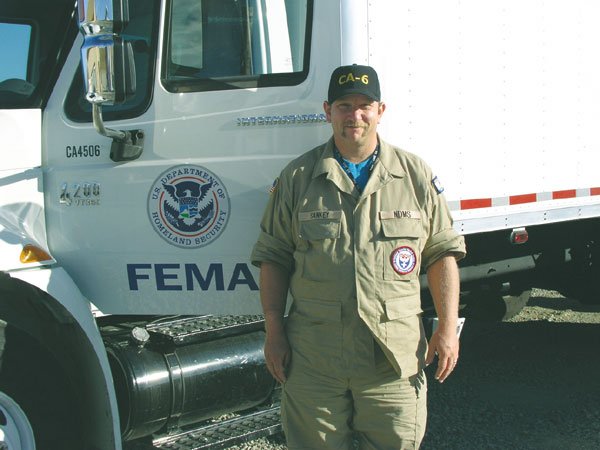When Kevin Sankey telephoned his wife Elizabeth Burwell two days
after Hurricane Katrina struck the Gulf Coast, his first words
were,
”
I’m alive!
”
Gilroy – When Kevin Sankey telephoned his wife Elizabeth Burwell two days after Hurricane Katrina struck the Gulf Coast, his first words were, “I’m alive!”
Sankey and his Disaster Medical Assistance Team had just escaped the Superdome in New Orleans – where 40,000 people were seeking shelter from the storm. With no electricity, food and safe water to drink, the people had turned into an angry violent mob, Sankey recalls. Gangs were raping women in the dark, people were fighting, and a National Guardsman had been shot the night before.
“We realized that if we were injured or dead, we couldn’t help anybody,” the Gilroy resident said. “We were running out of supplies with no more coming. The crowds were getting angry, our lives were in jeopardy.”
By Tuesday evening, he said the National Guard felt they were losing control of the situation. The next morning, Sankey said, National Guardsmen told other Federal Emergency Management Agency workers that they could no longer guarantee their safety in the devastated city of New Orleans. The guardsmen were leaving and if they wanted to save their own lives – the FEMA volunteers were told – they had better get out now.
“We left hastily, with nothing, leaving even our clothes behind,” Sankey said, home now from the horrors of the hurricane. “We were very much in fear, if the mob realized what was happening, there’s no thinking what they would have done. We snuck out through the back door and into a truck. We had to leave our patients behind and the thousands who were waiting to be treated.”
The decision to leave the sick, wounded and dying to the growing mob of scared, frustrated and angry people didn’t come easy according to Sankey.
“Getting out alive with my team in one piece had to be my only concern at that time,” he said. “I’ve never abandoned a patient. But we had to; it was us or them.”
By profession, Sankey is a trained respiratory care practitioner and a member of DMAT – a volunteer team organized under the National Disaster Medical System with FEMA. Their job is to provide emergency medical care and augment local medical capabilities during national disasters.
But for all his training, Sankey said no one was ready for what they saw at the Superdome. His crew was called to action Aug. 28. He arrived in Houston two days later while the storm was ravaging Louisiana and by the next day he was leaving Baton Rouge to relieve another DMAT team at the Superdome.
“You can never be prepared for what we encountered,” Sankey said. “There is no amount of preparation anyone can make for what we walked into at the Superdome. We’re a level one team, taught to be self-sustaining for 72 hours, but that’s nothing. There were just too many people, too many casualties. The National Guard stopped registering people at 20,000, and there were still thousands. We saw thousands. We were exhausted and worked 24 hours non-stop.”
It was dark in the Superdome, with a sea of people everywhere. No food, no water, except for the tepid water flooding the massive structure. It was hot and humid inside and the stench was horrific.
“It was surreal being there in this huge arena which was all dark, filled with thousands of people and the alarms sounding off and strobe lights flashing the whole time we were there,” Sankey said. “It was absolute squalid conditions to be in. The temperature was 90 degrees with 98 percent humidity. You had to seek shelter somewhere. People that tried to get out of the Superdome didn’t survive. There were bodies lying on the side of the roadways.”
It was after his team escaped from the Superdome that Sankey finally was able to call his wife. His cell phone was passed around so other people could call their families and let them know they were safe.
From the Superdome the group was assigned to two hospitals set up at Louisiana State University and then they moved to the New Orleans airport, under the protection of 82nd Airborne. People from the Superdome were transported there in a more orderly fashion, and medical teams were protected by the military.
“It was a serious military show of force after we lost the Superdome,” said Sankey.
Sankey said he disagrees with the criticisms of FEMA since the disaster. Witnessing the events gave him a clear perspective of the immense destruction.
“I think they tried, from our perspective, the resources were in place. Of 48 teams, only two teams were not deployed there,” Sankey said. “Our resources were there, but it was a scale of a disaster that just took its toll. It wasn’t so much the disaster, but when the levee broke, that’s when all hell broke lose. I’m looking at things from down on the ground, I don’t know what, beyond what I see except all the people in front of me waiting to be treated.”
After his experience, Sankey said in the event of a disaster of any kind, people have to be able to survive for at least a week. He indicated when disaster hits an area, you have to estimate it will take another 22 hours before FEMA can be set up and another four days before things start to happen and work gets filtered out.
“The idea that each person should be self-sustaining for 72 hours was realistic until Katrina came along,” he said. “The whole infrastructure collapses in a major disaster. There’s a break in communications, and the people who are supposed to help you have got their own problems too.”
Sankey arrived home Sept. 9, but he’s all packed again and expects to return soon.
He said, “We’re in a 24-hour mode now. I know we’ll be going back, I just don’t know when. Then there’s Hurricane Rita. It’s a big question where she’s gonna go.”














